

Getting the “Think-Pair-Share” Technique Right - ASCD. Most educators are familiar with Think-Pair-Share, a popular technique used to ask questions in class and promote peer collaboration and communication.
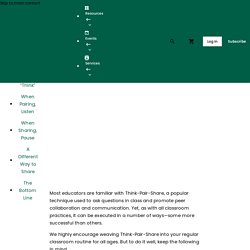
Yet, as with all classroom practices, it can be executed in a number of ways—some more successful than others. We highly encourage weaving Think-Pair-Share into your regular classroom routine for all ages. But to do it well, keep the following in mind. Don’t Skimp on the “Think” One of the biggest challenges to implementing Think-Pair-Share is making sure to not skimp on think. During thinking time, students can write down their initial responses and engage in necessary retrieval practice—recalling information from long-term memory without any notes or support to make the memory stronger and more accessible in the future. Think time prepares students so that when they do talk to their partner, they have something to share, potentially adding another factor: think, pair, compare, and share. When Pairing, Listen When Sharing, Pause. A systematic review of teacher guidance during collaborative learning in primary and secondary education.
Studies marked with * are included in the literature review, see also Table S2 (online only).
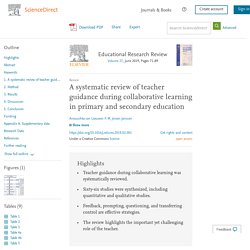
Almasi et al., 2001 J.F. Almasi, J.F. O'Flahavan, P. AryaA comparative analysis of student and teacher development in more and less proficient discussions of literature Reading Research Quarterly, 36 (2) (2001), pp. 96-120 Aronson and Bridgeman, 1979 E. Personality and Social Psychology Bulletin, 5 (4) (1979), pp. 438-446. Support for group work from cognitive load theory. Cognitive load theory provides limited support for the use of collaborative learning.

If a task is sufficiently complex, it will generate a high intrinsic cognitive load that may overwhelm an individual. However, if this cognitive load can be shared between members of a group then the intrinsic cognitive load experienced by each member will be reduced. The process of sharing will introduce its own cognitive costs associated with communication between group members and so, in theory, the conditions that favour group work should be those where these ‘transaction costs‘ are smaller than the intrinsic cognitive load that they replace. Sharing cognitive load in this way has become known in cognitive load theory as the ‘collective working memory effect’.
It is relatively new and there is not yet a huge amount of experimental data that tests the idea. In the first of these studies, high school students either worked individually or in threes. Like this: Like Loading... Research in education is great…until you start to try and use it. One reason that I’ve been interested in education research in the past couple of years is because, by luck/coincidence it mainly supports what I already do.
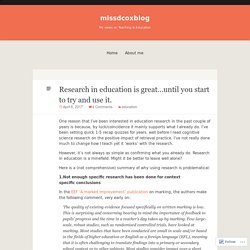
I’ve been setting quick 1-5 recap quizzes for years, well before I read cognitive science research on the positive impact of retrieval practice. I’ve not really done much to change how I teach yet it ‘works’ with the research. However, it’s not always as simple as confirming what you already do. Research in education is a minefield. Some Good News for Group Work? You may not know it, because our media didn’t report it: nor did our ministers shout it from the rooftops, but we did rather well in the PISA international comparison tests on Collaborative Problem Solving.
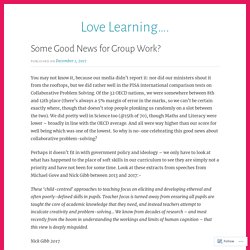
Of the 32 OECD nations, we were somewhere between 8th and 12th place (there’s always a 5% margin of error in the marks, so we can’t be certain exactly where, though that doesn’t stop people plonking us randomly on a slot between the two). We did pretty well in Science too (@15th of 70), though Maths and Literacy were lower – broadly in line with the OECD average. And all were way higher than our score for well being which was one of the lowest. Posters. Random Picker. The Structural Approach to Character Development. 20 Collaborative Learning Tips And Strategies For Teachers. 20 Collaborative Learning Tips And Strategies For Teachers by Miriam Clifford This post has been updated from a 2011 post.

There is an age old adage that says “two heads are better than one”. Consider collaboration in recent history: Watson and Crick or Page and Brin (Founders of Google). But did you know it was a collaborative Computer Club about basic programming at a middle school that brought together two minds that would change the future of computing? Yes, those two were of course Bill Gates and Paul Allen, the founders of Microsoft.
Collaborative learning teams are said to attain higher level thinking and preserve information for longer times than students working individually. Groups tend to learn through “discussion, clarification of ideas, and evaluation of other’s ideas.” Collaborative learning teams are said to attain higher level thinking and preserve information for longer times than students working individually. Many consider Vygotsky the father of “social learning”. 1. 2. DescriptionsOfStrategies.pdf. The Brown-Bag Teacher: Kagan Cooperative Learning. So, Kagan Cooperative Learning is HUGE in my district….every instructional person (teachers, collaborators, etc) is Kagan trained.
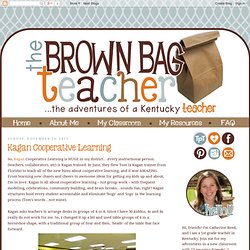
In June, they flew Tom (a Kagan trainer from Florida) to teach all of the new hires about cooperative learning, and it was AMAZING. From learning new chants and cheers to awesome ideas for getting my kids up and about, I’m in love. Kagan is all about cooperative learning – not group work – with frequent modeling, celebrations, community building, and brain breaks…sounds fun, right?